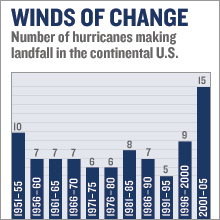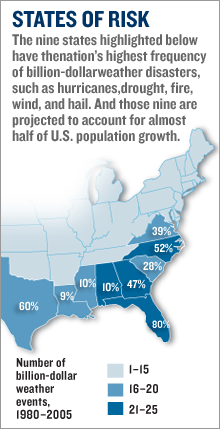|
Mother Nature ups the ante Insurers look to protect against the risk of another Katrina, but pass the cost onto the customer.
(Fortune Magazine) -- Mary Alice and José Martín's bungalow survived Katrina - but got hit in June. That's when Allstate informed the couple that their home, a mile from the glistening Gulf of Mexico, would no longer be covered for windstorm or hail. "Here it is the middle of hurricane season," Mrs. Martín fumes. "Who in the world is going to sell me a windstorm policy right now?" The Martíns are hardly alone. All along the Gulf Coast and Eastern seaboard, most major home and commercial insurers, including Allstate (Charts), Nationwide (Charts), State Farm, and St. Paul Travelers (Charts), are variously increasing premiums, ratcheting up deductibles, narrowing terms of coverage, and turning away new customers. In 18 states, from southern Texas to the northern tip of Maine, insurance companies are scrambling to reduce the risk of major hurricane-related payouts.
(This is an excerpt of a story that ran in the Sept. 4 Fortune. Read the entire story.) The upshot: For the 43 percent of the U.S. population who live and do business in these states, rates are likely to rise between 20 percent and 100 percent over the next year, according to the Insurance Information Institute. (In the rest of the country, premiums are expected to rise about 4 percent.) The insurance business is in the midst of a sea change. Unpredictable weather, American migratory patterns, and soaring real estate values are increasing risks for insurers and putting pressure on their financial prospects. In response, companies are changing the rules of engagement with their customers. It's not the best PR move for an industry still mired in post-Katrina lawsuits. Nonetheless, the effects are already being felt in places like Gulfport, Miss., and Cape Cod, where homeowners' insurance coverage is becoming more expensive, harder to get - or both. Critics blame the industry, saying it is using the trauma of Katrina as a ruse to raise rates. Insurers, though, blame the weather. Says Allstate CEO Edward Liddy: "We are in a period of increased land and sea surface temperatures. When you couple that with more people living along coasts and dramatically increased home values in those areas, that's when you step back and you say, 'Wait a minute. This is not yesterday's game.'" Publicly, insurers have not accepted the theory of global warming, which says that the accumulation of greenhouse gases - in part because of activities like burning fossil fuels - is changing weather patterns. What the industry does believe is that, for whatever reason, weather isn't what it used to be. So, who should pay for the costly repercussions of climate change? The answer is playing itself out in similar ways at various companies and in several regions. Concerned that the Northeast is overdue for a major hurricane - the last one was in 1938 - many property and casualty insurers are scaling back. In Massachusetts, Hingham Mutual Insurance, citing higher storm damage projections and rising reinsurance rates, said recently it will not renew some 6,500 homeowner policies this year on Cape Cod, Martha's Vineyard, and two coastal Massachusetts counties. Allstate, the nation's No. 2 personal-property insurer, said this year it would no longer offer new policies on Long Island, in New York City and Westchester County as part of a broad effort to reduce the company's "risk profile" along the Gulf and East Coasts. In South Carolina, Lexington Insurance (a division of AIG) is restricting new business to homes valued above $500,000. Allstate has stopped writing new policies in parts of the state. After being hit with seven hurricanes in the last two seasons, Florida is close to a full-blown insurance crisis. In 2005, Allstate canceled 95,000 homeowner's policies in Florida. The company plans not to renew 120,000 policies by November and is writing no new policies in the state. Allstate is severely limiting its risks in Florida, in part because the state is one in which "we do not get adequate rates in that regulated system," says Allstate CEO Edward Liddy. "If you talk to someone from Florida, they say, 'Boy, in the last five years, my home has gone up 80 percent in value,' " says Liddy. "But if you ask them, 'Well, are you paying 80 percent more for your insurance?' They would say, 'Oh, no! I only want to pay 8 percent more.' There's a disconnect." Gulfport, Miss., home to the Martíns, is as good a place as any to get a sense of how rising insurance costs can ripple through a community. Mayor Brent Warr, a 43-year-old Republican with the looks and shine of a fresh-out-of-the-box Ken doll, was seven weeks into his first term when Katrina hit. Almost a year later, he turns his dusty Ford pickup onto Highway 90. The Gulf of Mexico is on one side, empty lots on the other. Warr points excitedly at the sites of future construction projects. "That's all been zoned for condos," he says, waving his hand toward one lot. "A big hotel's going over here," he says, speeding past another. Despite Katrina, Gulfport's economic pulse is certainly beating. In the past year the city has added nearly 1,500 jobs, mostly in manufacturing and shipbuilding. The new economic activity, combined with an exodus of families affected by Katrina, has created a labor shortage. Still, while Gulfport is brimming with optimism, it is also feeling the tremors from the insurance upheaval. Some 3,500 homes were destroyed. Many of Gulfport's 71,000 residents (the population pre-Katrina) are waiting for their insurance settlements - or worse, they're involved in one of the many lawsuits against insurers over Katrina flood claims. "These insurance issues - the slow claims payments from Katrina and the skyrocketing premiums afterwards - are the only thing holding us back," says Warr. Critics of the insurance industry say the new models are just an excuse to raise premiums. In June, J. Robert Hunter, director of insurance at the Consumer Federation of America (CFA), testified before Congress that"it's clear that the insurance industry sought this move to higher rates." Insurers insist that they are facing real pressures. That is true enough, but don't get out the violins just yet. Insurance is the world's biggest industry ($3.4 trillion in annual revenues, compared with a mere $1.6 trillion for Big Oil). And even with all its disasters, 2005 was a very profitable year for U.S. property and casualty insurers. Collectively, they saw profits rise 11 percent. There is little doubt that a large chunk of the country will see its spending power, already eroded by high energy prices, further drained by escalating insurance costs. Moreover, the states being hit hardest may find sharply higher insurance costs a deterrent to new investment. In a sense, higher insurance rates are a tax - people have to pay up, and the rate affects everyone, directly or indirectly. One immediate outcome: "This has got to have a depressing effect on housing markets," says Robert Litan, an economist with the Brookings Institution. "The extra cost of insurance will be a haircut on the value of your house." The Martíns, by the way, finally did get insurance, this time from State Farm. But now the premium is $3,000, almost three times what they paid Allstate in 2005. (This is an excerpt of a story that ran in the Sept. 4 Fortune. Read the entire story.) |
|



